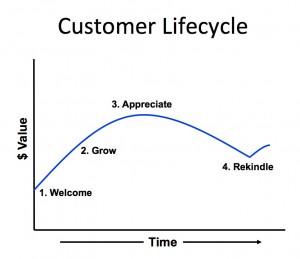How To Use The Customer Lifecycle When Picking Differentiating Values
When selecting your company’s differentiating values, talk to your customers. They can be like a mirror to see your company in a whole new light.
But be selective on which customers you choose to talk to. Not all customers are equal.
When relationships play an important role in business, different customers need to be treated differently. It depends where they are in the relationship.
A useful tool to help here is the Customer Lifecycle. It identifies how to treat customers as the relationship matures.
Customer Lifecycle
There are 4 stages to the Customer Lifecycle.
- Welcome. This is the starting point of the customer lifecycle. It’s when a customer makes their first purchase with your company. Regardless of the size of purchase or length of commitment, it all starts here. It’s the point where a prospective customer is no longer a prospect. They are now a customer. The common term marketers use here is “Acquisition”. But that’s not a very customer-friendly term. It also does not set the right tone for how employees should behave towards new customers. A better term is “Welcome”, which describes how every employee should behave and the desired interaction. Simply put, new customers should feel welcomed.
- Grow. Once a customer begins a relationship with your company, ideally this will grow into something more. Here marketers love the term “Upsell/Cross-sell”, which is also not a customer–friendly term. It feels very one-sided, where only the company benefits. But imagine if employees felt empowered to look for new ways to meet the needs of existing customers, adding value that is both timely and relevant. As any healthy relationship should experience, it grows deeper and richer over time. As long as your customer feels their needs are being met, and they are never being taken advantage of, trust increases. This leads to more revenue for your company, and more importantly ongoing revenue. Yes, this takes continuous effort. But long-term relationships are built here.
- Appreciate. A valued relationship doesn’t happen over night. It takes time to reach this point. Clearly your company is continuing to do something right when customers keep coming back. Yet, your company’s best and most valued customers are often the ones who complain the most. They can also be the most difficult to satisfy. That’s because these customers are investing a lot into the relationship, and they know it. They are demonstrating the most valuable attribute of loyalty. Not surprisingly, marketers talk about “Loyalty” programs here, in an effort to keep these customers. Yet, often the best thing you can do for your best customer is simply appreciate them. Be deliberate and say “thanks” on a regular basis, and ask: “what else can we do to make your life (or business) better?” Again, like any solid, long-lasting relationship, it’s important to put some thought into showing appreciation. Authentic appreciation is always appreciated.
- Rekindle. Life changes over time. The needs of your customers change. Or maybe your company’s products and services simply don’t meet your customer’s needs anymore. There are also competitive offerings, new products and services, and a whole world that’s changing faster than ever. So it’s not surprising that a customer might choose to stop buying from your company. The relationship has come to an end… or has it? Companies that are innovative and persevering look for ways to rekindle the relationship. It might be a new product or service that kick-starts the relationship, or different employees with whom they interact. While marketers refer to this stage as “Reactivation” it’s really about rekindling the relationship, looking for ways to start over and make a fresh start.
Values Across The Lifecycle
So how do values apply across the Customer Lifecycle?
Ideally, customers in the Welcome stage are buying because your company’s values resonate with them. But there may be many who make a purchase, yet your values mean nothing to them. In addition, most new customers don’t yet have a clear understanding of your company and what makes it unique.
The same is true during the Grow stage. This period of the relationship is more like a filter, where your best customers rise up, while others fall away. And customers in the Rekindle stage likely don’t have a good handle on what makes your company unique. Or worse, their view is biased because of some negative experience.
Your best customers are in the Appreciate stage.
This means that when you are assessing and selecting your differentiating values, look to your best customers for clues on which values matter. Customers in the Appreciate stage have the clearest understanding of your company. They know your company’s strengths and weaknesses – and they will likely be very open about this too. In addition, they can probably identify the subtle differences between your company and your competitors.
Of course, you can learn something from talking to customers across all stages of the Lifecycle. But if you want to hone in on the values that make a difference, that truly define what makes your company unique, talk to your best customers. They will provide you with the best value.
As a bonus, engaging your best customers to share their insights and feedback is another way to acknowledge you appreciate them!










